Royal Darwin Hospital: Clinical Audit Proposal for Fall Prevention
VerifiedAdded on 2023/06/04
|25
|5713
|264
Report
AI Summary
This document presents a clinical audit proposal focused on fall prevention within a local hospital setting, specifically addressing the high incidence of falls among the aging population in Australia and its associated healthcare costs. The proposal outlines a rationale for prioritizing fall prevention, highlighting the financial strain and physical consequences of falls, including injuries, hospital admissions, and mortality rates. It details a five-step process for implementing the audit, encompassing problem identification, criteria review, data collection, performance comparison, and improvement strategies. The proposed setting for the audit is Royal Darwin Hospital, where existing fall prevention strategies are to be evaluated against national standards and stakeholder involvement is emphasized. The proposal further elaborates on setting standards and criteria, aligning with the Australian Commission on Safety and Quality in Healthcare guidelines, and establishing measurable parameters for assessing the effectiveness of fall prevention measures.
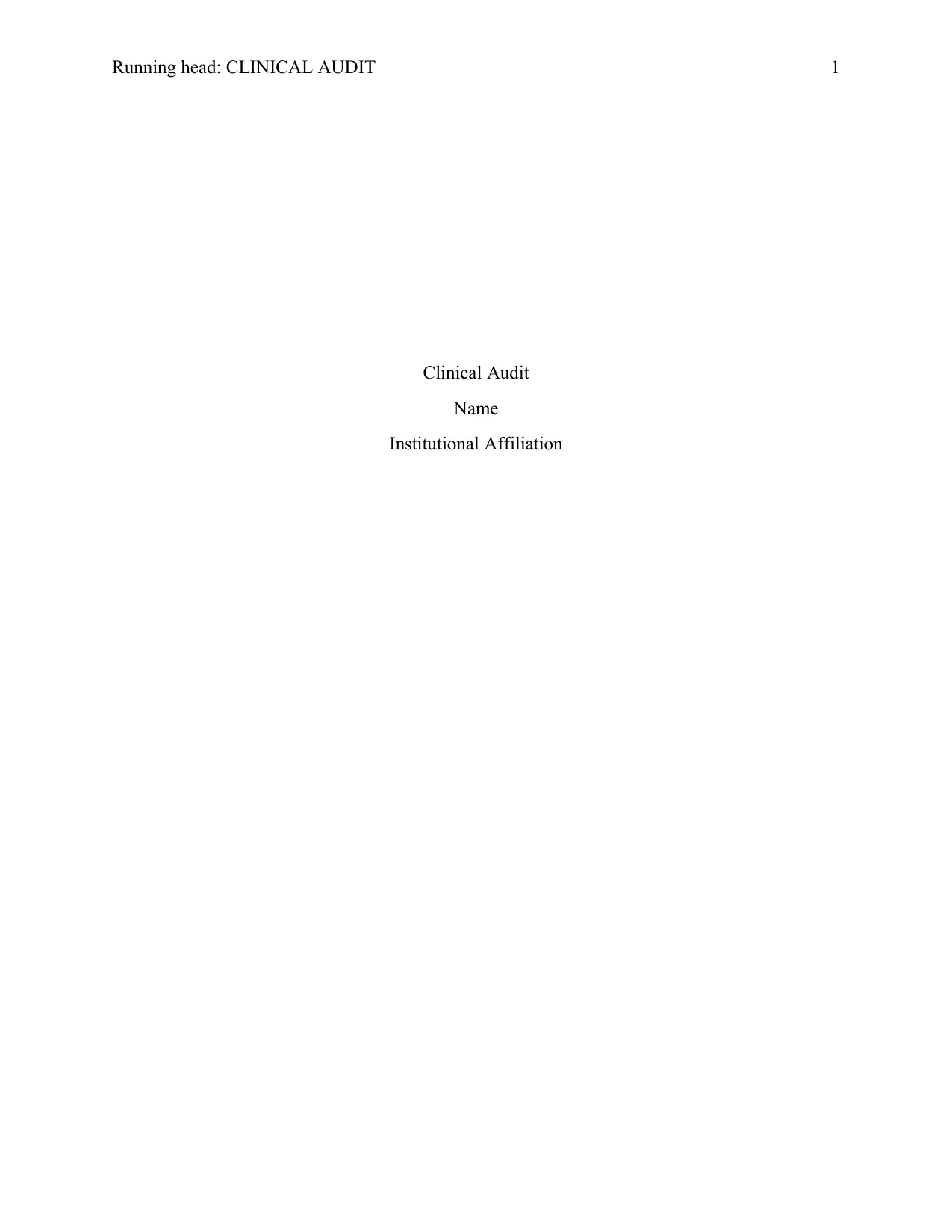
Running head: CLINICAL AUDIT 1
Clinical Audit
Name
Institutional Affiliation
Clinical Audit
Name
Institutional Affiliation
Paraphrase This Document
Need a fresh take? Get an instant paraphrase of this document with our AI Paraphraser
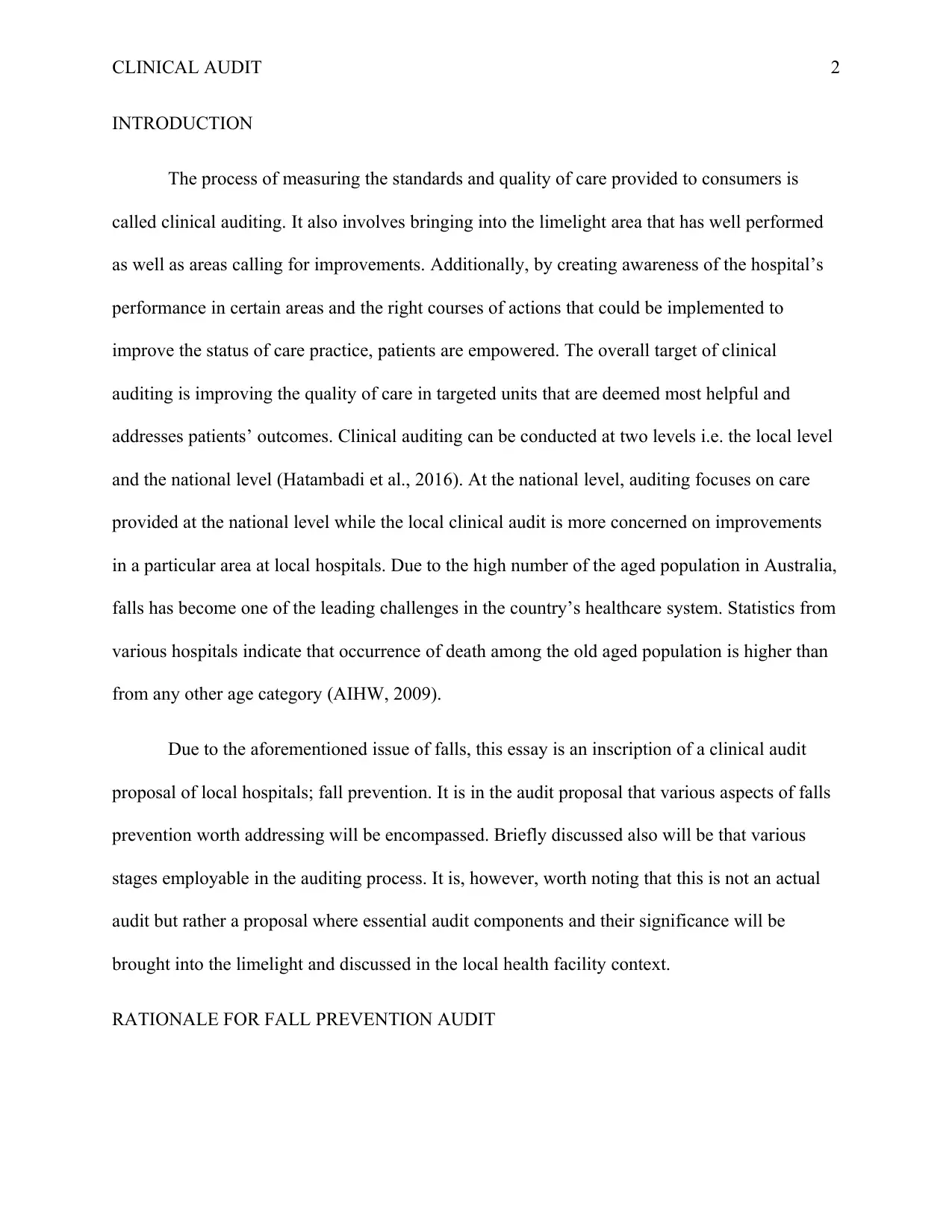
CLINICAL AUDIT 2
INTRODUCTION
The process of measuring the standards and quality of care provided to consumers is
called clinical auditing. It also involves bringing into the limelight area that has well performed
as well as areas calling for improvements. Additionally, by creating awareness of the hospital’s
performance in certain areas and the right courses of actions that could be implemented to
improve the status of care practice, patients are empowered. The overall target of clinical
auditing is improving the quality of care in targeted units that are deemed most helpful and
addresses patients’ outcomes. Clinical auditing can be conducted at two levels i.e. the local level
and the national level (Hatambadi et al., 2016). At the national level, auditing focuses on care
provided at the national level while the local clinical audit is more concerned on improvements
in a particular area at local hospitals. Due to the high number of the aged population in Australia,
falls has become one of the leading challenges in the country’s healthcare system. Statistics from
various hospitals indicate that occurrence of death among the old aged population is higher than
from any other age category (AIHW, 2009).
Due to the aforementioned issue of falls, this essay is an inscription of a clinical audit
proposal of local hospitals; fall prevention. It is in the audit proposal that various aspects of falls
prevention worth addressing will be encompassed. Briefly discussed also will be that various
stages employable in the auditing process. It is, however, worth noting that this is not an actual
audit but rather a proposal where essential audit components and their significance will be
brought into the limelight and discussed in the local health facility context.
RATIONALE FOR FALL PREVENTION AUDIT
INTRODUCTION
The process of measuring the standards and quality of care provided to consumers is
called clinical auditing. It also involves bringing into the limelight area that has well performed
as well as areas calling for improvements. Additionally, by creating awareness of the hospital’s
performance in certain areas and the right courses of actions that could be implemented to
improve the status of care practice, patients are empowered. The overall target of clinical
auditing is improving the quality of care in targeted units that are deemed most helpful and
addresses patients’ outcomes. Clinical auditing can be conducted at two levels i.e. the local level
and the national level (Hatambadi et al., 2016). At the national level, auditing focuses on care
provided at the national level while the local clinical audit is more concerned on improvements
in a particular area at local hospitals. Due to the high number of the aged population in Australia,
falls has become one of the leading challenges in the country’s healthcare system. Statistics from
various hospitals indicate that occurrence of death among the old aged population is higher than
from any other age category (AIHW, 2009).
Due to the aforementioned issue of falls, this essay is an inscription of a clinical audit
proposal of local hospitals; fall prevention. It is in the audit proposal that various aspects of falls
prevention worth addressing will be encompassed. Briefly discussed also will be that various
stages employable in the auditing process. It is, however, worth noting that this is not an actual
audit but rather a proposal where essential audit components and their significance will be
brought into the limelight and discussed in the local health facility context.
RATIONALE FOR FALL PREVENTION AUDIT
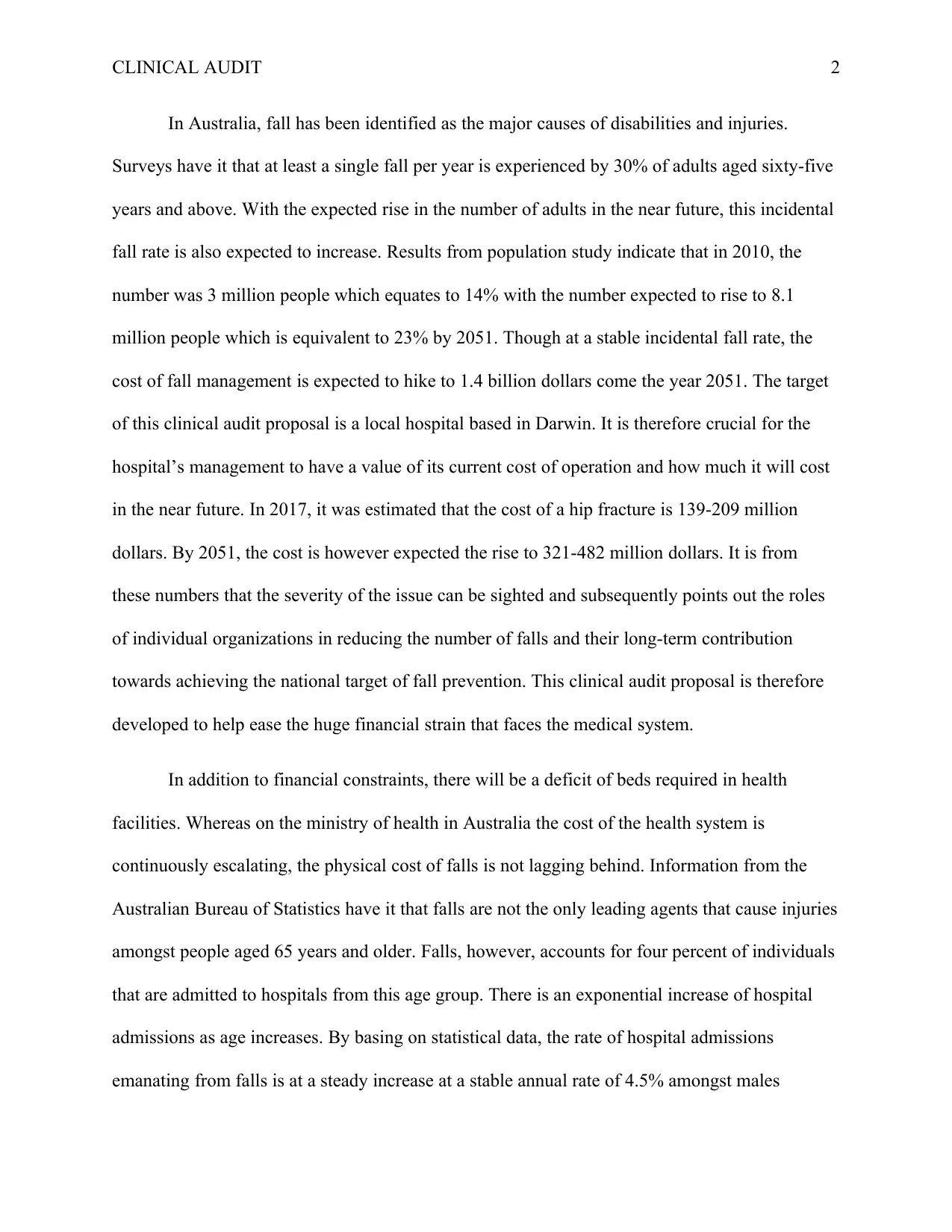
CLINICAL AUDIT 2
In Australia, fall has been identified as the major causes of disabilities and injuries.
Surveys have it that at least a single fall per year is experienced by 30% of adults aged sixty-five
years and above. With the expected rise in the number of adults in the near future, this incidental
fall rate is also expected to increase. Results from population study indicate that in 2010, the
number was 3 million people which equates to 14% with the number expected to rise to 8.1
million people which is equivalent to 23% by 2051. Though at a stable incidental fall rate, the
cost of fall management is expected to hike to 1.4 billion dollars come the year 2051. The target
of this clinical audit proposal is a local hospital based in Darwin. It is therefore crucial for the
hospital’s management to have a value of its current cost of operation and how much it will cost
in the near future. In 2017, it was estimated that the cost of a hip fracture is 139-209 million
dollars. By 2051, the cost is however expected the rise to 321-482 million dollars. It is from
these numbers that the severity of the issue can be sighted and subsequently points out the roles
of individual organizations in reducing the number of falls and their long-term contribution
towards achieving the national target of fall prevention. This clinical audit proposal is therefore
developed to help ease the huge financial strain that faces the medical system.
In addition to financial constraints, there will be a deficit of beds required in health
facilities. Whereas on the ministry of health in Australia the cost of the health system is
continuously escalating, the physical cost of falls is not lagging behind. Information from the
Australian Bureau of Statistics have it that falls are not the only leading agents that cause injuries
amongst people aged 65 years and older. Falls, however, accounts for four percent of individuals
that are admitted to hospitals from this age group. There is an exponential increase of hospital
admissions as age increases. By basing on statistical data, the rate of hospital admissions
emanating from falls is at a steady increase at a stable annual rate of 4.5% amongst males
In Australia, fall has been identified as the major causes of disabilities and injuries.
Surveys have it that at least a single fall per year is experienced by 30% of adults aged sixty-five
years and above. With the expected rise in the number of adults in the near future, this incidental
fall rate is also expected to increase. Results from population study indicate that in 2010, the
number was 3 million people which equates to 14% with the number expected to rise to 8.1
million people which is equivalent to 23% by 2051. Though at a stable incidental fall rate, the
cost of fall management is expected to hike to 1.4 billion dollars come the year 2051. The target
of this clinical audit proposal is a local hospital based in Darwin. It is therefore crucial for the
hospital’s management to have a value of its current cost of operation and how much it will cost
in the near future. In 2017, it was estimated that the cost of a hip fracture is 139-209 million
dollars. By 2051, the cost is however expected the rise to 321-482 million dollars. It is from
these numbers that the severity of the issue can be sighted and subsequently points out the roles
of individual organizations in reducing the number of falls and their long-term contribution
towards achieving the national target of fall prevention. This clinical audit proposal is therefore
developed to help ease the huge financial strain that faces the medical system.
In addition to financial constraints, there will be a deficit of beds required in health
facilities. Whereas on the ministry of health in Australia the cost of the health system is
continuously escalating, the physical cost of falls is not lagging behind. Information from the
Australian Bureau of Statistics have it that falls are not the only leading agents that cause injuries
amongst people aged 65 years and older. Falls, however, accounts for four percent of individuals
that are admitted to hospitals from this age group. There is an exponential increase of hospital
admissions as age increases. By basing on statistical data, the rate of hospital admissions
emanating from falls is at a steady increase at a stable annual rate of 4.5% amongst males
⊘ This is a preview!⊘
Do you want full access?
Subscribe today to unlock all pages.

Trusted by 1+ million students worldwide
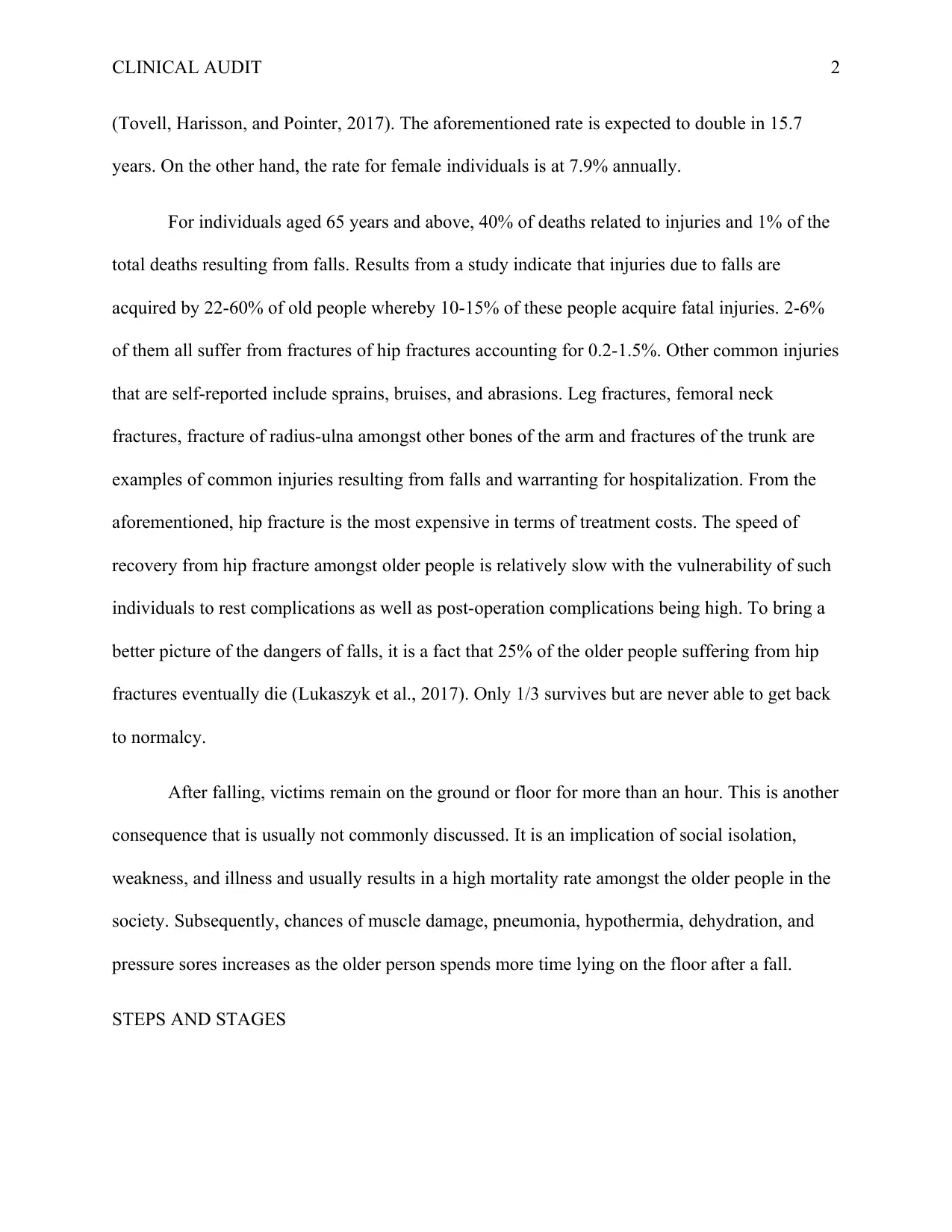
CLINICAL AUDIT 2
(Tovell, Harisson, and Pointer, 2017). The aforementioned rate is expected to double in 15.7
years. On the other hand, the rate for female individuals is at 7.9% annually.
For individuals aged 65 years and above, 40% of deaths related to injuries and 1% of the
total deaths resulting from falls. Results from a study indicate that injuries due to falls are
acquired by 22-60% of old people whereby 10-15% of these people acquire fatal injuries. 2-6%
of them all suffer from fractures of hip fractures accounting for 0.2-1.5%. Other common injuries
that are self-reported include sprains, bruises, and abrasions. Leg fractures, femoral neck
fractures, fracture of radius-ulna amongst other bones of the arm and fractures of the trunk are
examples of common injuries resulting from falls and warranting for hospitalization. From the
aforementioned, hip fracture is the most expensive in terms of treatment costs. The speed of
recovery from hip fracture amongst older people is relatively slow with the vulnerability of such
individuals to rest complications as well as post-operation complications being high. To bring a
better picture of the dangers of falls, it is a fact that 25% of the older people suffering from hip
fractures eventually die (Lukaszyk et al., 2017). Only 1/3 survives but are never able to get back
to normalcy.
After falling, victims remain on the ground or floor for more than an hour. This is another
consequence that is usually not commonly discussed. It is an implication of social isolation,
weakness, and illness and usually results in a high mortality rate amongst the older people in the
society. Subsequently, chances of muscle damage, pneumonia, hypothermia, dehydration, and
pressure sores increases as the older person spends more time lying on the floor after a fall.
STEPS AND STAGES
(Tovell, Harisson, and Pointer, 2017). The aforementioned rate is expected to double in 15.7
years. On the other hand, the rate for female individuals is at 7.9% annually.
For individuals aged 65 years and above, 40% of deaths related to injuries and 1% of the
total deaths resulting from falls. Results from a study indicate that injuries due to falls are
acquired by 22-60% of old people whereby 10-15% of these people acquire fatal injuries. 2-6%
of them all suffer from fractures of hip fractures accounting for 0.2-1.5%. Other common injuries
that are self-reported include sprains, bruises, and abrasions. Leg fractures, femoral neck
fractures, fracture of radius-ulna amongst other bones of the arm and fractures of the trunk are
examples of common injuries resulting from falls and warranting for hospitalization. From the
aforementioned, hip fracture is the most expensive in terms of treatment costs. The speed of
recovery from hip fracture amongst older people is relatively slow with the vulnerability of such
individuals to rest complications as well as post-operation complications being high. To bring a
better picture of the dangers of falls, it is a fact that 25% of the older people suffering from hip
fractures eventually die (Lukaszyk et al., 2017). Only 1/3 survives but are never able to get back
to normalcy.
After falling, victims remain on the ground or floor for more than an hour. This is another
consequence that is usually not commonly discussed. It is an implication of social isolation,
weakness, and illness and usually results in a high mortality rate amongst the older people in the
society. Subsequently, chances of muscle damage, pneumonia, hypothermia, dehydration, and
pressure sores increases as the older person spends more time lying on the floor after a fall.
STEPS AND STAGES
Paraphrase This Document
Need a fresh take? Get an instant paraphrase of this document with our AI Paraphraser
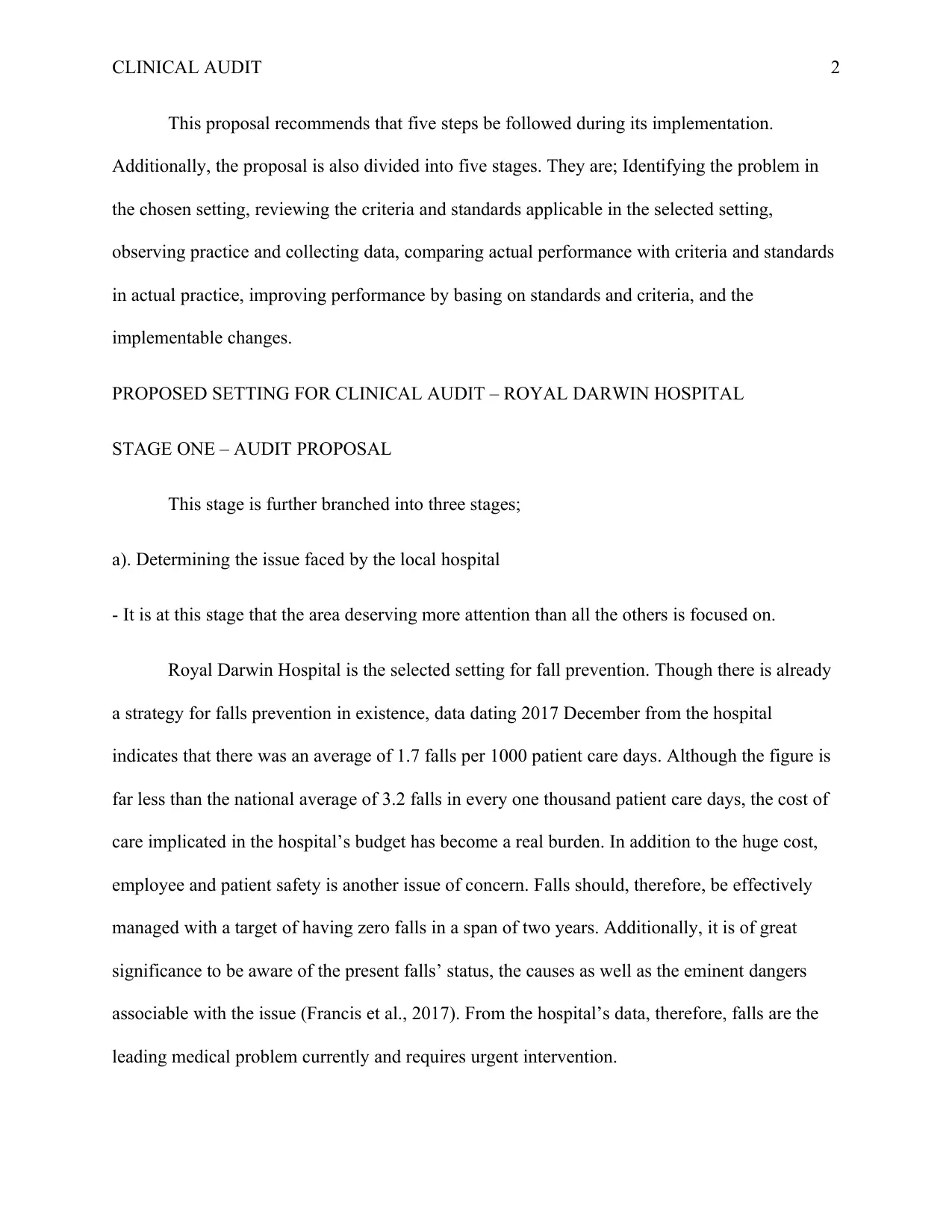
CLINICAL AUDIT 2
This proposal recommends that five steps be followed during its implementation.
Additionally, the proposal is also divided into five stages. They are; Identifying the problem in
the chosen setting, reviewing the criteria and standards applicable in the selected setting,
observing practice and collecting data, comparing actual performance with criteria and standards
in actual practice, improving performance by basing on standards and criteria, and the
implementable changes.
PROPOSED SETTING FOR CLINICAL AUDIT – ROYAL DARWIN HOSPITAL
STAGE ONE – AUDIT PROPOSAL
This stage is further branched into three stages;
a). Determining the issue faced by the local hospital
- It is at this stage that the area deserving more attention than all the others is focused on.
Royal Darwin Hospital is the selected setting for fall prevention. Though there is already
a strategy for falls prevention in existence, data dating 2017 December from the hospital
indicates that there was an average of 1.7 falls per 1000 patient care days. Although the figure is
far less than the national average of 3.2 falls in every one thousand patient care days, the cost of
care implicated in the hospital’s budget has become a real burden. In addition to the huge cost,
employee and patient safety is another issue of concern. Falls should, therefore, be effectively
managed with a target of having zero falls in a span of two years. Additionally, it is of great
significance to be aware of the present falls’ status, the causes as well as the eminent dangers
associable with the issue (Francis et al., 2017). From the hospital’s data, therefore, falls are the
leading medical problem currently and requires urgent intervention.
This proposal recommends that five steps be followed during its implementation.
Additionally, the proposal is also divided into five stages. They are; Identifying the problem in
the chosen setting, reviewing the criteria and standards applicable in the selected setting,
observing practice and collecting data, comparing actual performance with criteria and standards
in actual practice, improving performance by basing on standards and criteria, and the
implementable changes.
PROPOSED SETTING FOR CLINICAL AUDIT – ROYAL DARWIN HOSPITAL
STAGE ONE – AUDIT PROPOSAL
This stage is further branched into three stages;
a). Determining the issue faced by the local hospital
- It is at this stage that the area deserving more attention than all the others is focused on.
Royal Darwin Hospital is the selected setting for fall prevention. Though there is already
a strategy for falls prevention in existence, data dating 2017 December from the hospital
indicates that there was an average of 1.7 falls per 1000 patient care days. Although the figure is
far less than the national average of 3.2 falls in every one thousand patient care days, the cost of
care implicated in the hospital’s budget has become a real burden. In addition to the huge cost,
employee and patient safety is another issue of concern. Falls should, therefore, be effectively
managed with a target of having zero falls in a span of two years. Additionally, it is of great
significance to be aware of the present falls’ status, the causes as well as the eminent dangers
associable with the issue (Francis et al., 2017). From the hospital’s data, therefore, falls are the
leading medical problem currently and requires urgent intervention.
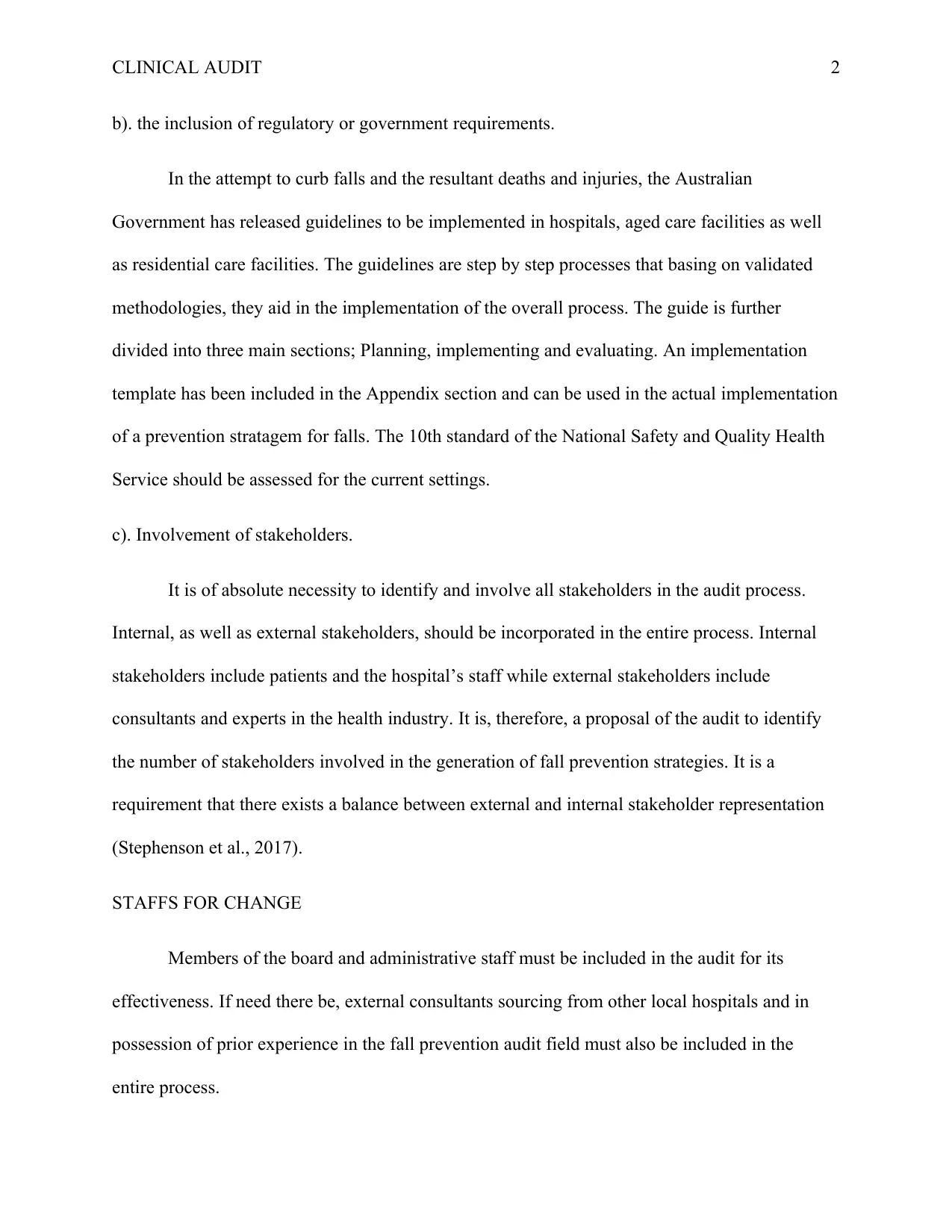
CLINICAL AUDIT 2
b). the inclusion of regulatory or government requirements.
In the attempt to curb falls and the resultant deaths and injuries, the Australian
Government has released guidelines to be implemented in hospitals, aged care facilities as well
as residential care facilities. The guidelines are step by step processes that basing on validated
methodologies, they aid in the implementation of the overall process. The guide is further
divided into three main sections; Planning, implementing and evaluating. An implementation
template has been included in the Appendix section and can be used in the actual implementation
of a prevention stratagem for falls. The 10th standard of the National Safety and Quality Health
Service should be assessed for the current settings.
c). Involvement of stakeholders.
It is of absolute necessity to identify and involve all stakeholders in the audit process.
Internal, as well as external stakeholders, should be incorporated in the entire process. Internal
stakeholders include patients and the hospital’s staff while external stakeholders include
consultants and experts in the health industry. It is, therefore, a proposal of the audit to identify
the number of stakeholders involved in the generation of fall prevention strategies. It is a
requirement that there exists a balance between external and internal stakeholder representation
(Stephenson et al., 2017).
STAFFS FOR CHANGE
Members of the board and administrative staff must be included in the audit for its
effectiveness. If need there be, external consultants sourcing from other local hospitals and in
possession of prior experience in the fall prevention audit field must also be included in the
entire process.
b). the inclusion of regulatory or government requirements.
In the attempt to curb falls and the resultant deaths and injuries, the Australian
Government has released guidelines to be implemented in hospitals, aged care facilities as well
as residential care facilities. The guidelines are step by step processes that basing on validated
methodologies, they aid in the implementation of the overall process. The guide is further
divided into three main sections; Planning, implementing and evaluating. An implementation
template has been included in the Appendix section and can be used in the actual implementation
of a prevention stratagem for falls. The 10th standard of the National Safety and Quality Health
Service should be assessed for the current settings.
c). Involvement of stakeholders.
It is of absolute necessity to identify and involve all stakeholders in the audit process.
Internal, as well as external stakeholders, should be incorporated in the entire process. Internal
stakeholders include patients and the hospital’s staff while external stakeholders include
consultants and experts in the health industry. It is, therefore, a proposal of the audit to identify
the number of stakeholders involved in the generation of fall prevention strategies. It is a
requirement that there exists a balance between external and internal stakeholder representation
(Stephenson et al., 2017).
STAFFS FOR CHANGE
Members of the board and administrative staff must be included in the audit for its
effectiveness. If need there be, external consultants sourcing from other local hospitals and in
possession of prior experience in the fall prevention audit field must also be included in the
entire process.
⊘ This is a preview!⊘
Do you want full access?
Subscribe today to unlock all pages.

Trusted by 1+ million students worldwide
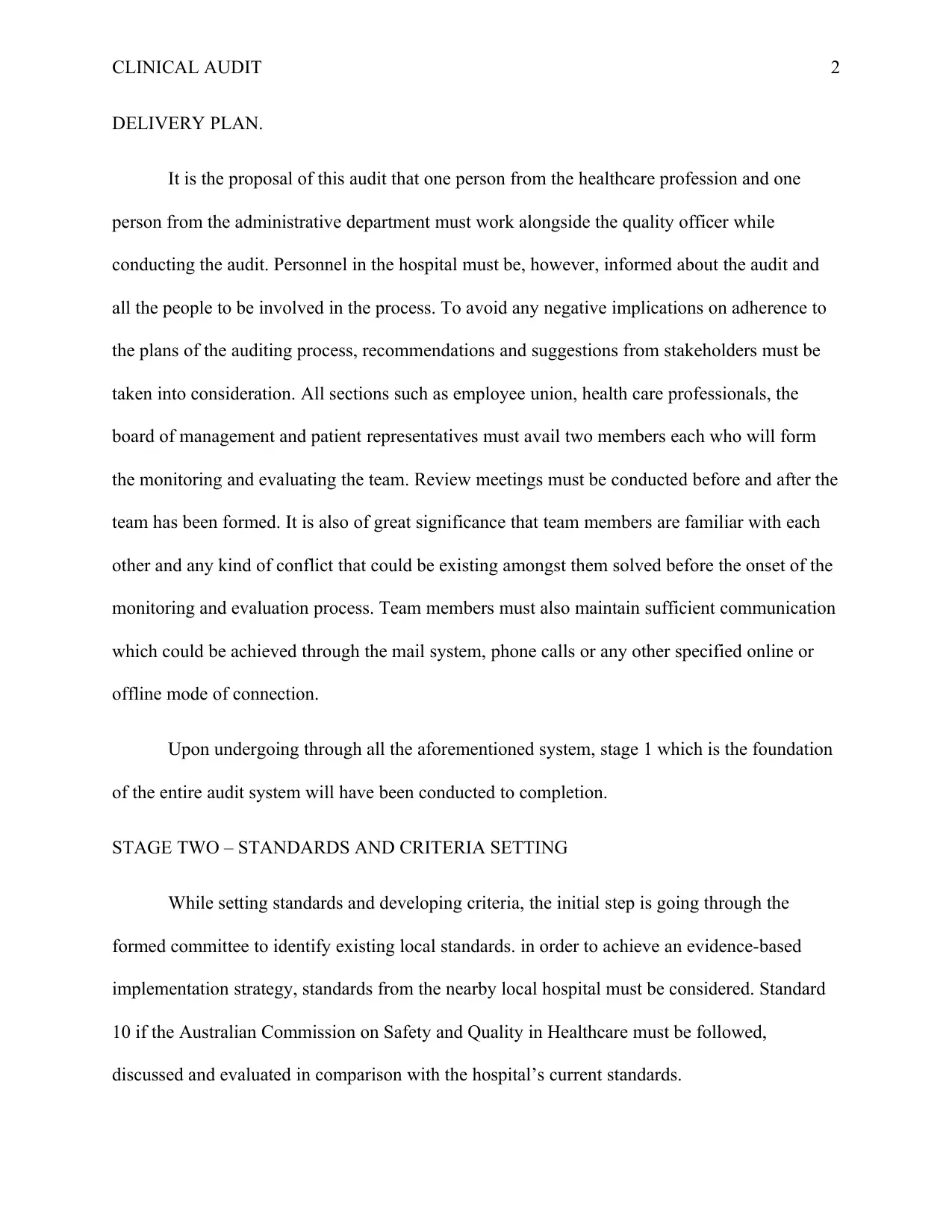
CLINICAL AUDIT 2
DELIVERY PLAN.
It is the proposal of this audit that one person from the healthcare profession and one
person from the administrative department must work alongside the quality officer while
conducting the audit. Personnel in the hospital must be, however, informed about the audit and
all the people to be involved in the process. To avoid any negative implications on adherence to
the plans of the auditing process, recommendations and suggestions from stakeholders must be
taken into consideration. All sections such as employee union, health care professionals, the
board of management and patient representatives must avail two members each who will form
the monitoring and evaluating the team. Review meetings must be conducted before and after the
team has been formed. It is also of great significance that team members are familiar with each
other and any kind of conflict that could be existing amongst them solved before the onset of the
monitoring and evaluation process. Team members must also maintain sufficient communication
which could be achieved through the mail system, phone calls or any other specified online or
offline mode of connection.
Upon undergoing through all the aforementioned system, stage 1 which is the foundation
of the entire audit system will have been conducted to completion.
STAGE TWO – STANDARDS AND CRITERIA SETTING
While setting standards and developing criteria, the initial step is going through the
formed committee to identify existing local standards. in order to achieve an evidence-based
implementation strategy, standards from the nearby local hospital must be considered. Standard
10 if the Australian Commission on Safety and Quality in Healthcare must be followed,
discussed and evaluated in comparison with the hospital’s current standards.
DELIVERY PLAN.
It is the proposal of this audit that one person from the healthcare profession and one
person from the administrative department must work alongside the quality officer while
conducting the audit. Personnel in the hospital must be, however, informed about the audit and
all the people to be involved in the process. To avoid any negative implications on adherence to
the plans of the auditing process, recommendations and suggestions from stakeholders must be
taken into consideration. All sections such as employee union, health care professionals, the
board of management and patient representatives must avail two members each who will form
the monitoring and evaluating the team. Review meetings must be conducted before and after the
team has been formed. It is also of great significance that team members are familiar with each
other and any kind of conflict that could be existing amongst them solved before the onset of the
monitoring and evaluation process. Team members must also maintain sufficient communication
which could be achieved through the mail system, phone calls or any other specified online or
offline mode of connection.
Upon undergoing through all the aforementioned system, stage 1 which is the foundation
of the entire audit system will have been conducted to completion.
STAGE TWO – STANDARDS AND CRITERIA SETTING
While setting standards and developing criteria, the initial step is going through the
formed committee to identify existing local standards. in order to achieve an evidence-based
implementation strategy, standards from the nearby local hospital must be considered. Standard
10 if the Australian Commission on Safety and Quality in Healthcare must be followed,
discussed and evaluated in comparison with the hospital’s current standards.
Paraphrase This Document
Need a fresh take? Get an instant paraphrase of this document with our AI Paraphraser
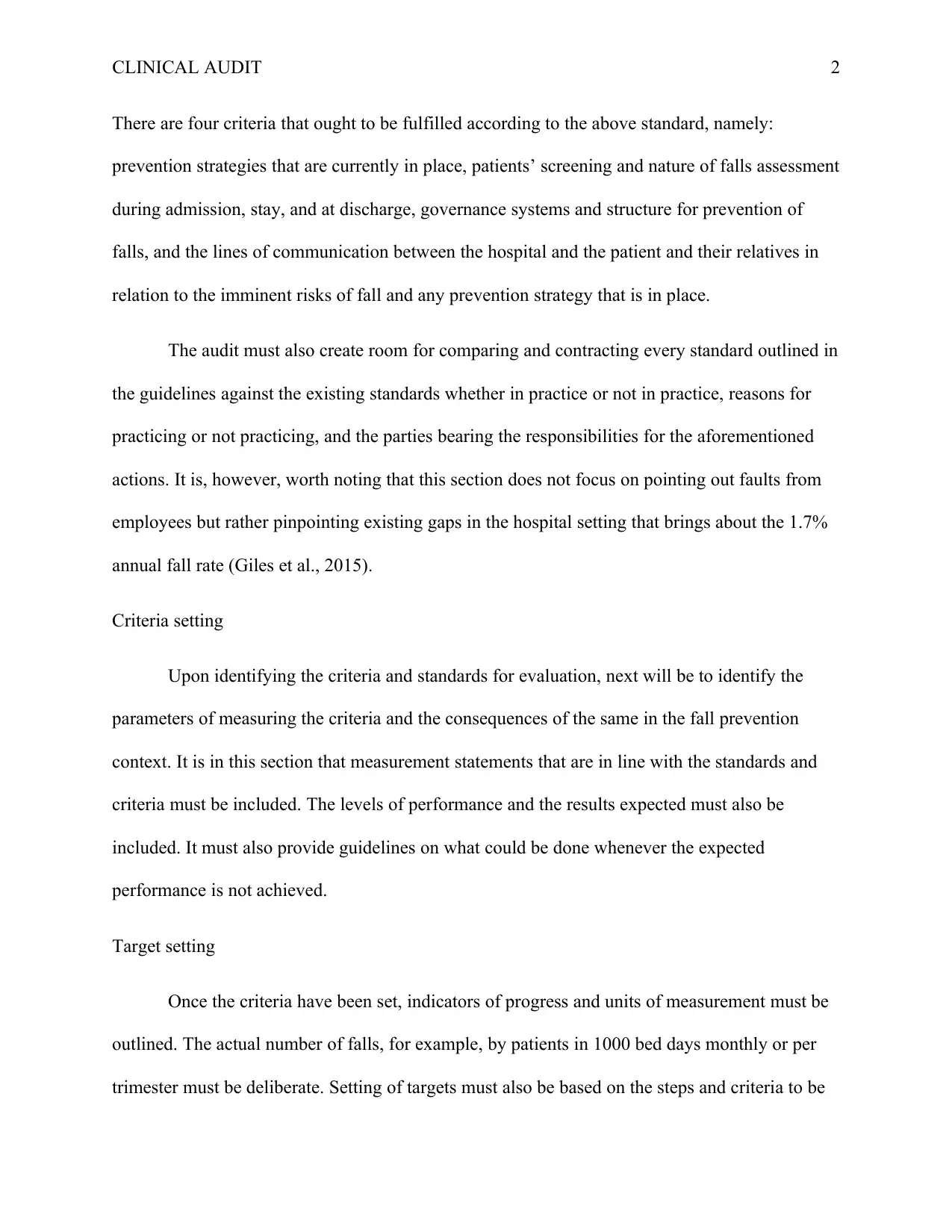
CLINICAL AUDIT 2
There are four criteria that ought to be fulfilled according to the above standard, namely:
prevention strategies that are currently in place, patients’ screening and nature of falls assessment
during admission, stay, and at discharge, governance systems and structure for prevention of
falls, and the lines of communication between the hospital and the patient and their relatives in
relation to the imminent risks of fall and any prevention strategy that is in place.
The audit must also create room for comparing and contracting every standard outlined in
the guidelines against the existing standards whether in practice or not in practice, reasons for
practicing or not practicing, and the parties bearing the responsibilities for the aforementioned
actions. It is, however, worth noting that this section does not focus on pointing out faults from
employees but rather pinpointing existing gaps in the hospital setting that brings about the 1.7%
annual fall rate (Giles et al., 2015).
Criteria setting
Upon identifying the criteria and standards for evaluation, next will be to identify the
parameters of measuring the criteria and the consequences of the same in the fall prevention
context. It is in this section that measurement statements that are in line with the standards and
criteria must be included. The levels of performance and the results expected must also be
included. It must also provide guidelines on what could be done whenever the expected
performance is not achieved.
Target setting
Once the criteria have been set, indicators of progress and units of measurement must be
outlined. The actual number of falls, for example, by patients in 1000 bed days monthly or per
trimester must be deliberate. Setting of targets must also be based on the steps and criteria to be
There are four criteria that ought to be fulfilled according to the above standard, namely:
prevention strategies that are currently in place, patients’ screening and nature of falls assessment
during admission, stay, and at discharge, governance systems and structure for prevention of
falls, and the lines of communication between the hospital and the patient and their relatives in
relation to the imminent risks of fall and any prevention strategy that is in place.
The audit must also create room for comparing and contracting every standard outlined in
the guidelines against the existing standards whether in practice or not in practice, reasons for
practicing or not practicing, and the parties bearing the responsibilities for the aforementioned
actions. It is, however, worth noting that this section does not focus on pointing out faults from
employees but rather pinpointing existing gaps in the hospital setting that brings about the 1.7%
annual fall rate (Giles et al., 2015).
Criteria setting
Upon identifying the criteria and standards for evaluation, next will be to identify the
parameters of measuring the criteria and the consequences of the same in the fall prevention
context. It is in this section that measurement statements that are in line with the standards and
criteria must be included. The levels of performance and the results expected must also be
included. It must also provide guidelines on what could be done whenever the expected
performance is not achieved.
Target setting
Once the criteria have been set, indicators of progress and units of measurement must be
outlined. The actual number of falls, for example, by patients in 1000 bed days monthly or per
trimester must be deliberate. Setting of targets must also be based on the steps and criteria to be
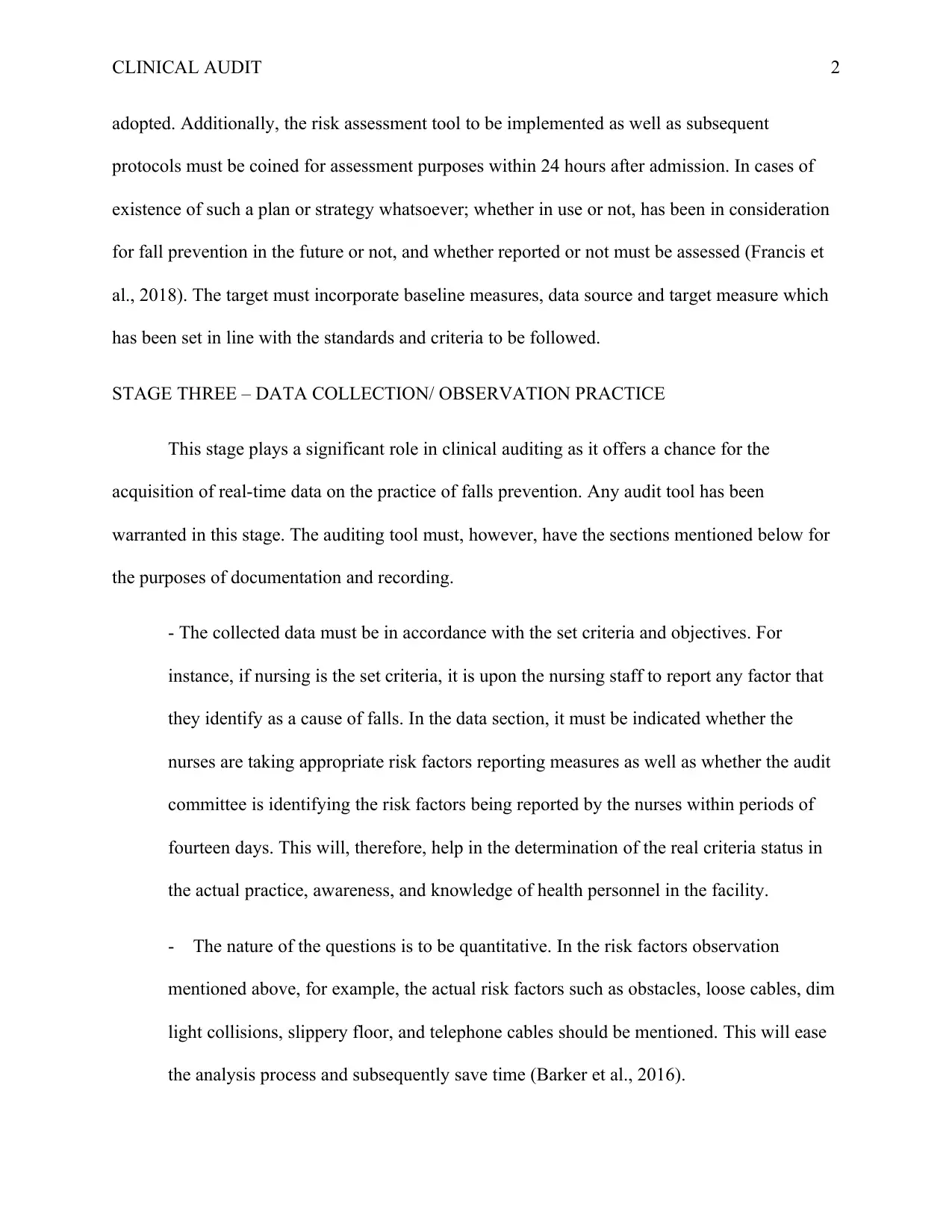
CLINICAL AUDIT 2
adopted. Additionally, the risk assessment tool to be implemented as well as subsequent
protocols must be coined for assessment purposes within 24 hours after admission. In cases of
existence of such a plan or strategy whatsoever; whether in use or not, has been in consideration
for fall prevention in the future or not, and whether reported or not must be assessed (Francis et
al., 2018). The target must incorporate baseline measures, data source and target measure which
has been set in line with the standards and criteria to be followed.
STAGE THREE – DATA COLLECTION/ OBSERVATION PRACTICE
This stage plays a significant role in clinical auditing as it offers a chance for the
acquisition of real-time data on the practice of falls prevention. Any audit tool has been
warranted in this stage. The auditing tool must, however, have the sections mentioned below for
the purposes of documentation and recording.
- The collected data must be in accordance with the set criteria and objectives. For
instance, if nursing is the set criteria, it is upon the nursing staff to report any factor that
they identify as a cause of falls. In the data section, it must be indicated whether the
nurses are taking appropriate risk factors reporting measures as well as whether the audit
committee is identifying the risk factors being reported by the nurses within periods of
fourteen days. This will, therefore, help in the determination of the real criteria status in
the actual practice, awareness, and knowledge of health personnel in the facility.
- The nature of the questions is to be quantitative. In the risk factors observation
mentioned above, for example, the actual risk factors such as obstacles, loose cables, dim
light collisions, slippery floor, and telephone cables should be mentioned. This will ease
the analysis process and subsequently save time (Barker et al., 2016).
adopted. Additionally, the risk assessment tool to be implemented as well as subsequent
protocols must be coined for assessment purposes within 24 hours after admission. In cases of
existence of such a plan or strategy whatsoever; whether in use or not, has been in consideration
for fall prevention in the future or not, and whether reported or not must be assessed (Francis et
al., 2018). The target must incorporate baseline measures, data source and target measure which
has been set in line with the standards and criteria to be followed.
STAGE THREE – DATA COLLECTION/ OBSERVATION PRACTICE
This stage plays a significant role in clinical auditing as it offers a chance for the
acquisition of real-time data on the practice of falls prevention. Any audit tool has been
warranted in this stage. The auditing tool must, however, have the sections mentioned below for
the purposes of documentation and recording.
- The collected data must be in accordance with the set criteria and objectives. For
instance, if nursing is the set criteria, it is upon the nursing staff to report any factor that
they identify as a cause of falls. In the data section, it must be indicated whether the
nurses are taking appropriate risk factors reporting measures as well as whether the audit
committee is identifying the risk factors being reported by the nurses within periods of
fourteen days. This will, therefore, help in the determination of the real criteria status in
the actual practice, awareness, and knowledge of health personnel in the facility.
- The nature of the questions is to be quantitative. In the risk factors observation
mentioned above, for example, the actual risk factors such as obstacles, loose cables, dim
light collisions, slippery floor, and telephone cables should be mentioned. This will ease
the analysis process and subsequently save time (Barker et al., 2016).
⊘ This is a preview!⊘
Do you want full access?
Subscribe today to unlock all pages.

Trusted by 1+ million students worldwide
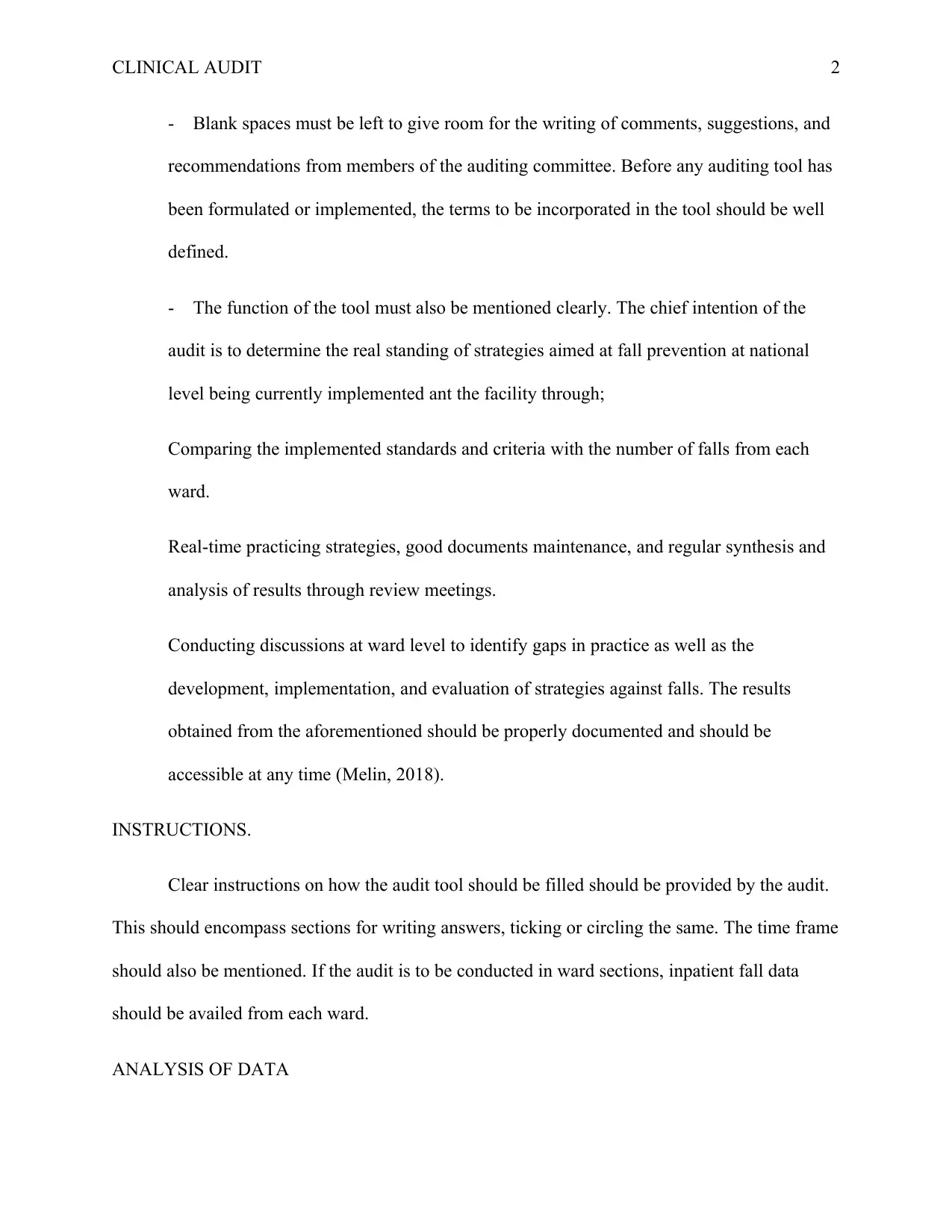
CLINICAL AUDIT 2
- Blank spaces must be left to give room for the writing of comments, suggestions, and
recommendations from members of the auditing committee. Before any auditing tool has
been formulated or implemented, the terms to be incorporated in the tool should be well
defined.
- The function of the tool must also be mentioned clearly. The chief intention of the
audit is to determine the real standing of strategies aimed at fall prevention at national
level being currently implemented ant the facility through;
Comparing the implemented standards and criteria with the number of falls from each
ward.
Real-time practicing strategies, good documents maintenance, and regular synthesis and
analysis of results through review meetings.
Conducting discussions at ward level to identify gaps in practice as well as the
development, implementation, and evaluation of strategies against falls. The results
obtained from the aforementioned should be properly documented and should be
accessible at any time (Melin, 2018).
INSTRUCTIONS.
Clear instructions on how the audit tool should be filled should be provided by the audit.
This should encompass sections for writing answers, ticking or circling the same. The time frame
should also be mentioned. If the audit is to be conducted in ward sections, inpatient fall data
should be availed from each ward.
ANALYSIS OF DATA
- Blank spaces must be left to give room for the writing of comments, suggestions, and
recommendations from members of the auditing committee. Before any auditing tool has
been formulated or implemented, the terms to be incorporated in the tool should be well
defined.
- The function of the tool must also be mentioned clearly. The chief intention of the
audit is to determine the real standing of strategies aimed at fall prevention at national
level being currently implemented ant the facility through;
Comparing the implemented standards and criteria with the number of falls from each
ward.
Real-time practicing strategies, good documents maintenance, and regular synthesis and
analysis of results through review meetings.
Conducting discussions at ward level to identify gaps in practice as well as the
development, implementation, and evaluation of strategies against falls. The results
obtained from the aforementioned should be properly documented and should be
accessible at any time (Melin, 2018).
INSTRUCTIONS.
Clear instructions on how the audit tool should be filled should be provided by the audit.
This should encompass sections for writing answers, ticking or circling the same. The time frame
should also be mentioned. If the audit is to be conducted in ward sections, inpatient fall data
should be availed from each ward.
ANALYSIS OF DATA
Paraphrase This Document
Need a fresh take? Get an instant paraphrase of this document with our AI Paraphraser
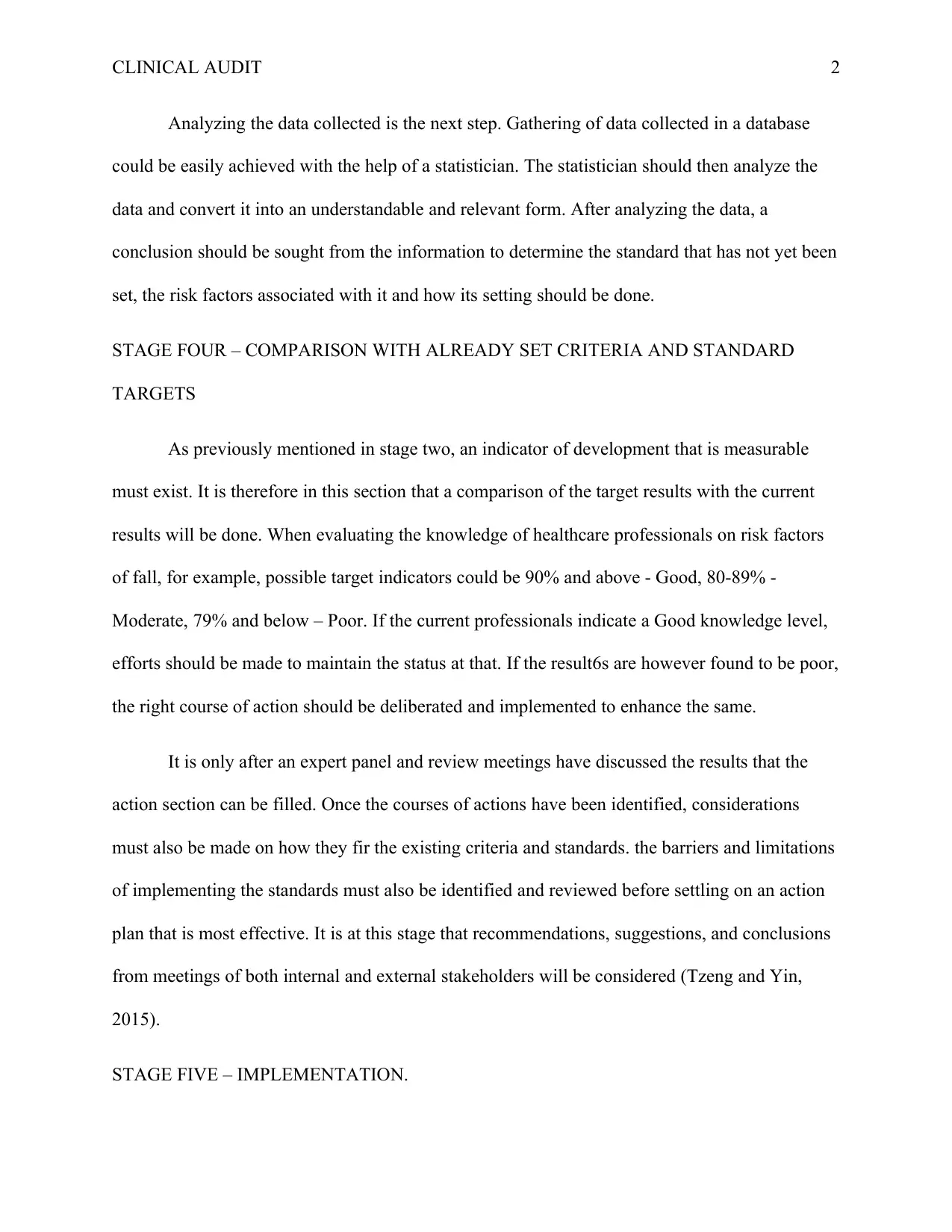
CLINICAL AUDIT 2
Analyzing the data collected is the next step. Gathering of data collected in a database
could be easily achieved with the help of a statistician. The statistician should then analyze the
data and convert it into an understandable and relevant form. After analyzing the data, a
conclusion should be sought from the information to determine the standard that has not yet been
set, the risk factors associated with it and how its setting should be done.
STAGE FOUR – COMPARISON WITH ALREADY SET CRITERIA AND STANDARD
TARGETS
As previously mentioned in stage two, an indicator of development that is measurable
must exist. It is therefore in this section that a comparison of the target results with the current
results will be done. When evaluating the knowledge of healthcare professionals on risk factors
of fall, for example, possible target indicators could be 90% and above - Good, 80-89% -
Moderate, 79% and below – Poor. If the current professionals indicate a Good knowledge level,
efforts should be made to maintain the status at that. If the result6s are however found to be poor,
the right course of action should be deliberated and implemented to enhance the same.
It is only after an expert panel and review meetings have discussed the results that the
action section can be filled. Once the courses of actions have been identified, considerations
must also be made on how they fir the existing criteria and standards. the barriers and limitations
of implementing the standards must also be identified and reviewed before settling on an action
plan that is most effective. It is at this stage that recommendations, suggestions, and conclusions
from meetings of both internal and external stakeholders will be considered (Tzeng and Yin,
2015).
STAGE FIVE – IMPLEMENTATION.
Analyzing the data collected is the next step. Gathering of data collected in a database
could be easily achieved with the help of a statistician. The statistician should then analyze the
data and convert it into an understandable and relevant form. After analyzing the data, a
conclusion should be sought from the information to determine the standard that has not yet been
set, the risk factors associated with it and how its setting should be done.
STAGE FOUR – COMPARISON WITH ALREADY SET CRITERIA AND STANDARD
TARGETS
As previously mentioned in stage two, an indicator of development that is measurable
must exist. It is therefore in this section that a comparison of the target results with the current
results will be done. When evaluating the knowledge of healthcare professionals on risk factors
of fall, for example, possible target indicators could be 90% and above - Good, 80-89% -
Moderate, 79% and below – Poor. If the current professionals indicate a Good knowledge level,
efforts should be made to maintain the status at that. If the result6s are however found to be poor,
the right course of action should be deliberated and implemented to enhance the same.
It is only after an expert panel and review meetings have discussed the results that the
action section can be filled. Once the courses of actions have been identified, considerations
must also be made on how they fir the existing criteria and standards. the barriers and limitations
of implementing the standards must also be identified and reviewed before settling on an action
plan that is most effective. It is at this stage that recommendations, suggestions, and conclusions
from meetings of both internal and external stakeholders will be considered (Tzeng and Yin,
2015).
STAGE FIVE – IMPLEMENTATION.
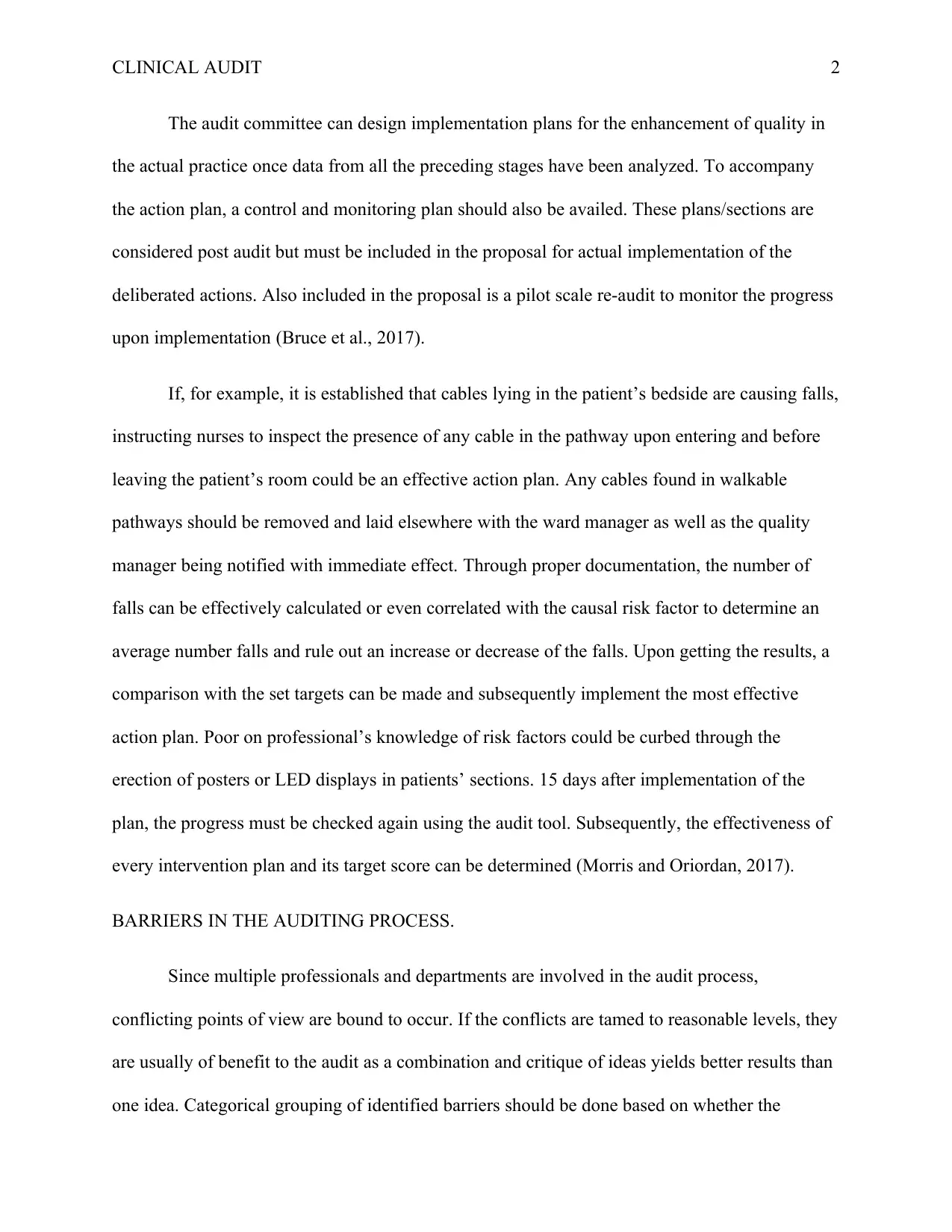
CLINICAL AUDIT 2
The audit committee can design implementation plans for the enhancement of quality in
the actual practice once data from all the preceding stages have been analyzed. To accompany
the action plan, a control and monitoring plan should also be availed. These plans/sections are
considered post audit but must be included in the proposal for actual implementation of the
deliberated actions. Also included in the proposal is a pilot scale re-audit to monitor the progress
upon implementation (Bruce et al., 2017).
If, for example, it is established that cables lying in the patient’s bedside are causing falls,
instructing nurses to inspect the presence of any cable in the pathway upon entering and before
leaving the patient’s room could be an effective action plan. Any cables found in walkable
pathways should be removed and laid elsewhere with the ward manager as well as the quality
manager being notified with immediate effect. Through proper documentation, the number of
falls can be effectively calculated or even correlated with the causal risk factor to determine an
average number falls and rule out an increase or decrease of the falls. Upon getting the results, a
comparison with the set targets can be made and subsequently implement the most effective
action plan. Poor on professional’s knowledge of risk factors could be curbed through the
erection of posters or LED displays in patients’ sections. 15 days after implementation of the
plan, the progress must be checked again using the audit tool. Subsequently, the effectiveness of
every intervention plan and its target score can be determined (Morris and Oriordan, 2017).
BARRIERS IN THE AUDITING PROCESS.
Since multiple professionals and departments are involved in the audit process,
conflicting points of view are bound to occur. If the conflicts are tamed to reasonable levels, they
are usually of benefit to the audit as a combination and critique of ideas yields better results than
one idea. Categorical grouping of identified barriers should be done based on whether the
The audit committee can design implementation plans for the enhancement of quality in
the actual practice once data from all the preceding stages have been analyzed. To accompany
the action plan, a control and monitoring plan should also be availed. These plans/sections are
considered post audit but must be included in the proposal for actual implementation of the
deliberated actions. Also included in the proposal is a pilot scale re-audit to monitor the progress
upon implementation (Bruce et al., 2017).
If, for example, it is established that cables lying in the patient’s bedside are causing falls,
instructing nurses to inspect the presence of any cable in the pathway upon entering and before
leaving the patient’s room could be an effective action plan. Any cables found in walkable
pathways should be removed and laid elsewhere with the ward manager as well as the quality
manager being notified with immediate effect. Through proper documentation, the number of
falls can be effectively calculated or even correlated with the causal risk factor to determine an
average number falls and rule out an increase or decrease of the falls. Upon getting the results, a
comparison with the set targets can be made and subsequently implement the most effective
action plan. Poor on professional’s knowledge of risk factors could be curbed through the
erection of posters or LED displays in patients’ sections. 15 days after implementation of the
plan, the progress must be checked again using the audit tool. Subsequently, the effectiveness of
every intervention plan and its target score can be determined (Morris and Oriordan, 2017).
BARRIERS IN THE AUDITING PROCESS.
Since multiple professionals and departments are involved in the audit process,
conflicting points of view are bound to occur. If the conflicts are tamed to reasonable levels, they
are usually of benefit to the audit as a combination and critique of ideas yields better results than
one idea. Categorical grouping of identified barriers should be done based on whether the
⊘ This is a preview!⊘
Do you want full access?
Subscribe today to unlock all pages.

Trusted by 1+ million students worldwide
1 out of 25
Related Documents
Your All-in-One AI-Powered Toolkit for Academic Success.
+13062052269
info@desklib.com
Available 24*7 on WhatsApp / Email
![[object Object]](/_next/static/media/star-bottom.7253800d.svg)
Unlock your academic potential
Copyright © 2020–2025 A2Z Services. All Rights Reserved. Developed and managed by ZUCOL.





